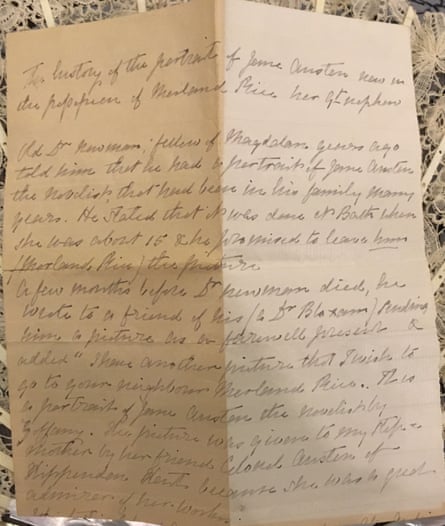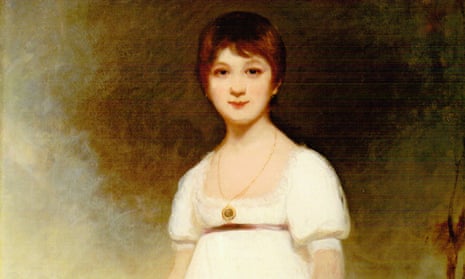An overlooked note that may have been written by Jane Austen’s great-niece Fanny Caroline Lefroy could put an end to the long-running question mark over an oil painting its owners believe is a depiction of the novelist as a teenager – a claim that has long been disputed by art experts.
Showing a young girl in a flowing white muslin dress with a cap of brown hair and a charming half-smile, the painting is owned by the Rice family, direct descendants of one of Austen’s brothers. The Rices claim it shows Austen herself, and that it was commissioned from the portrait painter Ozias Humphry in 1788, when 12-year-old Jane and her sister Cassandra were taken to visit their great-uncle Francis in Kent. According to the Rices, Humphry’s 1788 accounts, now held at the British Library, list a bill to Francis Austen for 13 guineas.
But the identity of the painting has proved controversial for decades. Experts including the National Portrait Gallery, which granted the picture a licence for sale abroad because it believed it was not of Austen, have said that the style of the dress dates it to later than 1800. The doubt over the picture’s subject meant that when the Rice portrait was put up for auction by Christie’s in 2007, it failed to sell.
Were the portrait authenticated, it would be the only professional likeness of one of the world’s most beloved authors. There are currently only two accepted portraits of Austen, both sketches by her sister Cassandra, although in 2011 scholar Paula Byrne claimed to have found a lost portrait of the novelist.
Now the Rice family have uncovered a new piece of evidence they say adds further weight to their claim. The unsigned note believed to have been written by Lefroy has been passed to the Rices through family links. Kept in Austen’s writing desk, it had been overlooked, said John Nettlefold, son of the painting’s owner Anne Rice, until its current owner noticed the small brown envelope containing it was marked “history of the portrait of Jane Austen”. Lefroy was born three years after Austen’s death, but her mother, who was the daughter of the novelist’s brother James, knew Austen well.

The note reads: “The history of the portrait of Jane Austen now in the possession of Morland Rice her Gt nephew. Old Dr Newman, fellow of Magdalen years ago told him that he had a portrait of Jane Austen the novelist, that had been in his family many years. He stated that it was done at Bath when she was about 15 & he promised to leave him (Morland Rice) the picture. A few months before Dr Newman died, he wrote to a friend of his (a Dr Bloxam) sending him a picture as a farewell present & added ‘I have another picture that I wish to go to your neighbour Morland Rice. This a portrait of Jane Austen the novelist by Zoffany. Her picture was given to my step-mother by her friend Colonel Austen of Kippendon [sic], Kent because she was a great admirer of her works.’”
The note names the artist Johann Zoffany, to whom the painting has been attributed in the past. It is unsigned, but after comparing it with other documents held in the Hampshire Record Office, the Rices claim it is very likely the hand of Lefroy.
“This came out of the blue,” said Nettlefold. “The first thing we wanted to find out was, was it Fanny Caroline Lefroy? So we had four people look at it. There are lots of examples of her handwriting in the Hampshire Record Office, and we believe it is … 100% certainty – an absolute match.”
Kelly M McDonald, an independent scholar who is researching the letters and diaries of Emma Austen-Leigh, the wife of Jane Austen’s nephew James Edward Austen-Leigh, agreed. “The handwriting of the snippet is consistent with the signed (FC Lefroy) letter in the Hampshire Record Office,” said McDonald. “There is the ‘A’ with its loop at the top; the lowercase ‘g’; even the truncated downstroke to the lowercase ‘y’. The “I” is top-heavy in both. But look at the ‘S’: very consistent.”
According to Nettlefold, the letter is sufficient evidence to establish the painting’s subject as Austen. “This is written before there was any kind of issue,” he said. “The problems only started in the 1930s … Unfortunately, there was then an institutional enmity towards it and it just got worse and worse.
“But all I can say is, this note was written by Jane’s great-niece at a time when there was no controversy over this picture whatsoever. She’s absolutely emphatic about the fact it’s a portrait of Jane Austen. In the note she says exactly where it came from – why do we have to presume all these people are liars? If she was lying and it was a letter to someone else, fine. But why would you write a note to yourself and lie to yourself?”
In 2012, digital photographic analysis revealed writing on the painting that appeared to show the novelist’s name, and also that of Humphry, as well as the date 1789. The Rice family say that there are now five pieces of primary evidence that point towards the portrait being Austen, and are pursuing a meeting with the director of the National Portrait Gallery to discuss its authenticity.
The Rice family would like to sell the portrait, if and when it is officially certified as being of Austen, said Nettlefold: “My mother absolutely wants this to be recognised and loved by Jane Austen scholars and fans around the world. It just seems to me that it’s incredibly sad that this beautiful picture is not recognised for what it is.”
Currently, the painting is kept in a vault, “where only we can see her”, said Nettlefold. “It will be awesome when she is on a wall where all who love her work will have access. She needs to go to a great gallery.”
A statement from the National Portrait Gallery said: “We have read the latest article on the Rice portrait with interest. We will add this and any new evidence provided to the live research file which is maintained on the portrait.”
